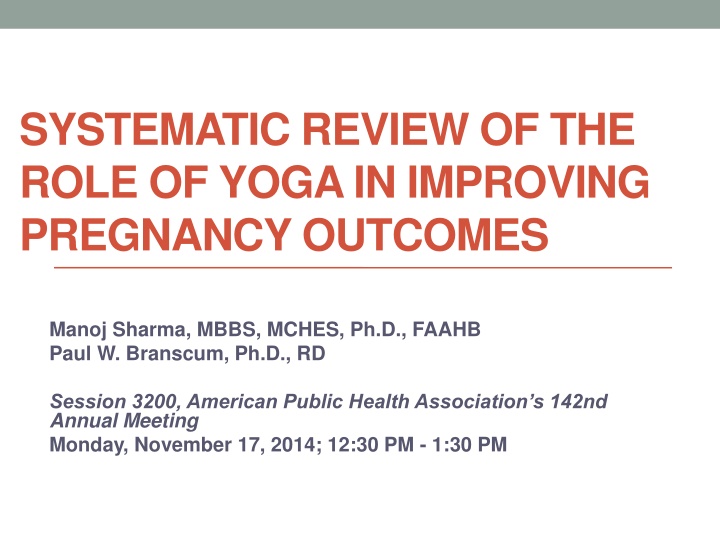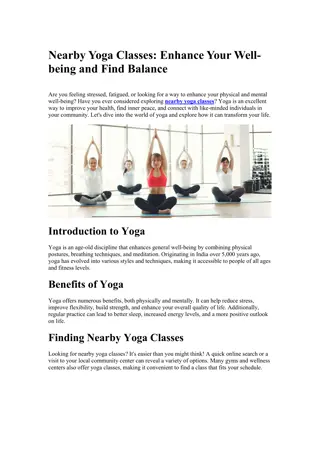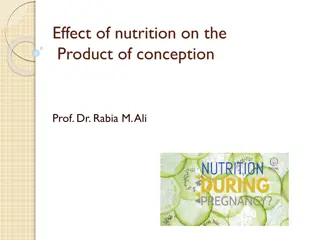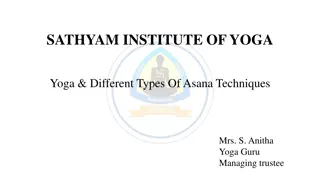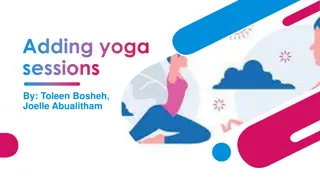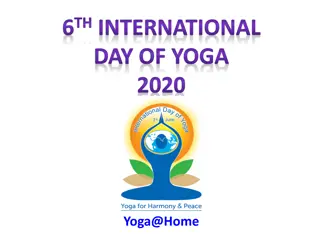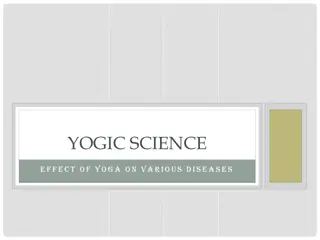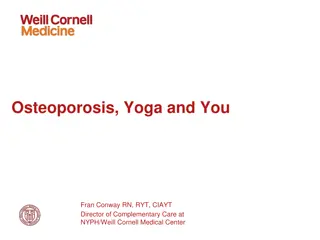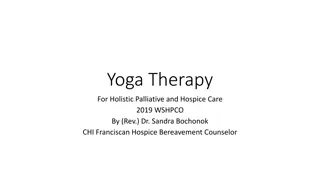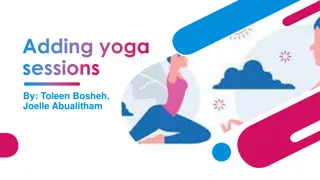Yoga's Impact on Pregnancy Outcomes: A Systematic Review
Exploring the potential of yoga in improving pregnancy outcomes, this systematic review delves into the role of yoga in addressing common complications of pregnancy like hypertension, diabetes, and fetal growth issues. The ancient practice of yoga, with its ability to reduce stress and induce relaxation, is considered as a complementary approach for enhancing prenatal and postnatal care, aiming to alleviate emotional stress and anxiety that can impact birth outcomes.
Download Presentation

Please find below an Image/Link to download the presentation.
The content on the website is provided AS IS for your information and personal use only. It may not be sold, licensed, or shared on other websites without obtaining consent from the author.If you encounter any issues during the download, it is possible that the publisher has removed the file from their server.
You are allowed to download the files provided on this website for personal or commercial use, subject to the condition that they are used lawfully. All files are the property of their respective owners.
The content on the website is provided AS IS for your information and personal use only. It may not be sold, licensed, or shared on other websites without obtaining consent from the author.
E N D
Presentation Transcript
SYSTEMATIC REVIEW OF THE ROLE OF YOGA IN IMPROVING PREGNANCY OUTCOMES Manoj Sharma, MBBS, MCHES, Ph.D., FAAHB Paul W. Branscum, Ph.D., RD Session 3200, American Public Health Association s 142nd Annual Meeting Monday, November 17, 2014; 12:30 PM - 1:30 PM
Introduction The birth rate of the world is estimated as 18.9 births/1,000 population which translates to about 255 births per minute or 4.3 births every second Prenatal care, natal care and post natal care are salient pillars for public health programming However prenatal care is often not associated with improved birth outcomes Emotional stress and anxiety during the prenatal period have been associated with premature births, low birth weight and adverse fetal neurodevelopment and child outcomes
Common Complications of Pregnancy Pregnancy induced hypertension Preeclampsia Eclampsia Gestational diabetes mellitus Premature rupture of amniotic fluid Small fetus for gestational age Large fetus for gestational age Intrauterine growth retardation Low APGAR score at birth In order to make pregnancy event free and improve birth outcomes yoga has been suggested as an alternative and complementary system of medicine to be practiced both during prenatal and post natal periods
Yoga & Characteristics of Yoga Users Yoga is an ancient practice originating in India over 4,000 years ago Yoga has been demonstrated to reduce stress and induce relaxation 2002 National Health Interview Survey (NHIS) found about 5.1% of US population or over 14 million people were yoga users 85% Caucasians 76% females Mean age of 39.5 years A majority of yoga users (61%) felt yoga was important in maintaining health
Stages of Ashtangayoga Yama: Techniques for successful living in society Niyama: Techniques for managing and purifying self Asaana: Postures for physical homeostasis & mental balance Pranayama: Breathing techniques for physical homeostasis & mental balance Pratihara: Techniques for developing dispassion toward senses for mental balance and equanimity Dharana: Concentration techniques for mental balance and equanimity Dhyana: Meditation techniques for mental balance and equanimity Samadhi: Universal consciousness
Previous study A literature review was published in 2008 that examined published studies on the effectiveness of mind-body interventions conducted during pregnancy on perceived stress, mood, and perinatal outcomes. The study summarized the results from 12 such trials and found that sample sizes were small and not all studies used control groups. The results showed there was modest evidence for the efficacy of mind-body interventions during pregnancy in the form of higher birth weight, shorter length of labor, fewer instrument-assisted births, and reduced perceived stress and anxiety.
Research Questions Has yoga been found to be efficacious in improving experience and birth outcomes of pregnancy since the 2008 review? Is there sufficient data available to draw conclusions regarding the efficacy of yoga in pregnancy? What are the methodological limitations of present research studies and how can these be addressed in future research? What are the common outcome measures measured by studies and which ones are more important for future studies?
Methods The method used in this study was a systematic qualitative review of interventions obtained from following databases: CINAHL (Cumulative Index to Nursing & Allied Health) MEDLINE Alt HealthWatch
Inclusion & exclusion criteria for studies Inclusion criteria: (1) be published in the English language; (2) included in following databases: Medline, CINAHL (Cumulative Index to Nursing and Allied Health), or Alt HealthWatch (3) between the years January 2008 and July 2013 (4) include any form or school of yoga as an intervention (5) use any quantitative study design for evaluation (6) implemented in prenatal or postnatal period of pregnancy Exclusion criteria: (1) studies that did not evaluate the intervention or implemented a qualitative design (2) studies done in 2007 or before; (3) articles published in languages other than English (4) did not index in 3 selected databases
Phase I: Boolean Logic CINAHL, Medline, Alt HealthWatch Terms: Yoga AND Pregnancy; Yoga AND Pregnancy Outcome; Yoga AND pregnant; Yoga AND Pregnant women Articles Before 2007 Excluded Medline n= 42 Alt Watch n=64 CINAHL n= 54 Total articles remaining = 323 Total Articles Returned: Medline n= 67; 19; 26; 30 = 142 Alt HealthWatch n=74; 7; 45; 50 = 176 CINAHL n=113; 4; 24; 24 = 165 Total = 483 Duplicate Articles (n=179) Other language ( n=3) Review/Discussion/Other Articles (n=126) Phase II: Distillation Total Articles Excluded (n=308) Total Articles Remaining (n=15) Phase III: Manuscript and Reference Review Total Articles Excluded: (n=2) Total Articles Included: (n=13) Not quantitative (n=2) Articles satisfying inclusion criteria, distillation, and review (n=13)
Summary of Results1 A total of 13 studies met the inclusion criteria 12 were in the prenatal period and 1 was in the post natal period. Of the 13 interventions five were done in the United States, four in India, two in Taiwan and one each in Korea and Thailand. Of the 13 interventions seven used randomized controlled designs, one used quasi experimental design, four used pretest posttest designs, and one was an observational nested case control design The mean sample size calculated for all 13 studies in this review was 67.38 with a standard deviation of 38.55 and range of 15 to 138
Summary of Results2 The sites of the yoga intervention for arthritis were primarily in hospitals (n=8), followed by outpatient clinics (n=2), and community settings (n=2), and for one study the site could not be determined. The school of yoga was not identified by four studies. It was identified as Mindfulness based Iyengar yoga by two studies, Integrated yoga by three studies, Hatha yoga by one study, Sophrology by one study, combination of yoga and Tai chi by one study and combination of yoga and Pilates by one study The duration of yoga interventions varied from 4 hours to 48 hours. The mean was 17.1 hours (s.d. 12.9).
Outcome Measures Used Mental Health: Stress Anxiety Depression Related to Birth outcomes: Length of labor Birth weight of newborn Apgar score Less commonly used measures: Assessment of complications Sleep assessment Quality of life Platelet count Serum uric acid
Interventions1 Authors, year Design & sample size Chuntharap at et al. 2008 Randomized controlled trial: (n=37 x 2) Age Intervention modality Intervention dosage Salient findings 18-35 years Asanas, Om chanting, breathing exercises, yoga nidra (relaxation), dhyana (meditation) Sophrology or dynamic relaxation based on yoga Six, 60-min yoga sessions [6 hours] -- Maternal comfort was higher for yoga group -- Labor pain was less in yoga group -- Duration of first stage of labor and total duration of labor was shorter in yoga group -- No difference (p > 0.05) in the no. of neonates born with meconium-stained amniotic fluid or the number of babies with Apgar score 7 at 1 and 5 minutes Kim et al. 2008 Nested case-control design: (n=69 x 2) Exp.: 29.6 0.3; Cont.: 28.8 0.4 2 hours per week for 4 weeks [8 hours]
Interventions2 Authors, year Design & sample size Age Intervention modality Intervention dosage Salient findings Mean age 30.4 years Mindfulness- based yoga intervention of Iyengar yoga 7 weeks; 75 minute each session [9 hours] -- Significant decrease in perceived stress (p <.05) from pretest to posttest -- There was no change in state anxiety Beddoe et al. 2009 Pretest posttest design (n=16) Satyapriya et al. 2009 Randomized controlled trial (n=45 x 2) Yoga 26.23 2.98 Cont. 25.47 2.87 years Integrated Approach to Yoga 16 weeks, 60 min each session [16 hours] -- In the yoga group perceived stress decreased by 31.57% as opposed to an increase by 6.60% in the control group (p=0.001).
Interventions3 Authors, year Design & sample size Beddoe et al. 2010 Pretest posttest design (n=15) Age Intervention modality Intervention dosage Salient findings -- Women who took the intervention in the second trimester had significantly fewer awakenings and less perceived sleep disturbance at posttest than at pretest. -- No effect for women in the third trimester -- Yoga group performed better in Physical (effect size = 0.48), Psychological (effect size = 0.65), Social Relationships (effect size = 0.65), and the General Health (effect size = 0.65) domains Age range 25-37 years Mindfulness- based yoga intervention with Iyengar yoga 7 weeks; 2 hour each session per week [14 hours] Rakhshani et al. 2010 Randomized controlled trial (n=51 x 2) 1-hour three times a week from 20th to 36th week of gestation (16 weeks) [48 hours] Yoga 26.23 2.98 Cont. 25.47 2.87 years Integrated Approach to Yoga
Interventions4 Authors, year, Design & sample size Sun et al. 2010 Quasi experiment al design (n= 45, 43) 3.9 Field et al. 2012 RCT (n=28 x 3) Age Intervention modality Intervention dosage Salient findings Yoga 28.2 3.1 Cont 28.5 Asanas, relaxation, and meditation Videotape + practice at home x 12- 14 weeks [18-21 hrs.] -- Yoga group had fewer pregnancy discomforts than control group (38.28 vs. 43.26) at 38-40 weeks of gestation Mean 26.6 years Yogic asanas 20 min twice weekly x 12 weeks [8 hours] -- For yoga group depression scores decreased (F= 82.40, p<.001); anxiety scores decreased (F= 26.23, p< .001) as compared to control. -- Symptoms of depression were significantly reduced (p < 0.025) Muzik et al. 2012 Pretest posttest (n= 18) Mean age 32.41 (4.98) years Mindfulness yoga 90 min session per week for 10 weeks [15 hours]
Interventions5 Authors, year, Design & sample size Rakhshani et al. 2012 RCT (n= 30, 38) Age Intervention modality Intervention dosage Salient findings Mean age about 27 years Breathing exercises, postures, and meditation 1-hour session x thrice a week [28 hours] -- Yoga group had significantly fewer cases of Intrauterine Growth Retardation (p=0.05) and preterm deliveries (p=0.04) -- Yoga group had fewer cases of pregnancy induced hypertension (p=0.02) and preeclampsia (p=0.04) -- Tai chi/yoga group had lower depression scores (p<0.001) -- Tai chi/yoga group had lower negative affect (p < 0.001) and somatic/ vegetative symptoms scores (p <0.01) Field et al. 2013 RCT (n =46 x 2) Mean age 26.6 ( 5.5) years Tai chi and yoga combined 20 min session per week for a period of 12 weeks [4 hours]
Interventions6 Authors, year Design & sample size Jayashree et al. 2013 RCT (n=30, 38) Age Intervention modality Intervention dosage Salient findings Yoga 27.7 5.1 Cont. 27.2 5.2 Integrated meditative yoga 1 hour session three days / week for 12 weeks [36 hours] -- In the yoga group there were 3 (10.3%) cases of pregnancy induced hypertension/ preeclampsia while there were 12 (37.7%) cases in the control group (p = 0.018) -- Statistically significant reductions in the participants body weight, body fat percentage, fat mass and basic metabolic rate were observed (p < 0.001) Ko et al. 2013 Post natal Pretest posttest design (n=23) Mean age 34.07 4.18 years Yoga and Pilates Exercise Program Once a week 60 min. session for 12 weeks by a professional coach [12 hours]
Discussion & Conclusions From the 12 prenatal studies a majority (n=8) demonstrated positive changes in maternal psychological or birth outcome measures related to pregnancy. Three studies had mixed results where some of the indicators showed improvement while other measures did not change. One study that used nested case control design showed no change. The review looked at 13 studies (12 prenatal studies) of which seven used randomized controlled designs. The sample sizes have generally been small with only two studies having sample size over 100 Wide variability of intervention dosage that has ranged from 4 hours to 48 hours with a mean of 17.1 hours
